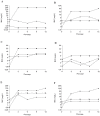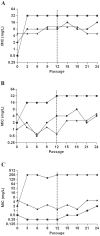Resistance development of cystic fibrosis respiratory pathogens when exposed to fosfomycin and tobramycin alone and in combination under aerobic and anaerobic conditions
- PMID: 23936095
- PMCID: PMC3723830
- DOI: 10.1371/journal.pone.0069763
Resistance development of cystic fibrosis respiratory pathogens when exposed to fosfomycin and tobramycin alone and in combination under aerobic and anaerobic conditions
Abstract
Although antibiotics from different classes are frequently prescribed in combination to prevent the development of resistance amongst Cystic Fibrosis (CF) respiratory pathogens, there is a lack of data as to the efficacy of this approach. We have previously shown that a 4:1 (w/w) combination of fosfomycin and tobramycin (F:T) has excellent activity against CF pathogens with increased activity under physiologically relevant anaerobic conditions. Therefore, the aim of this study was to determine whether F:T could delay or prevent the onset of resistance compared to either fosfomycin or tobramycin alone under aerobic and anaerobic conditions. The frequency of spontaneous mutants arising following exposure to fosfomycin, tobramycin and F:T was determined for clinical Pseudomonas aeruginosa and MRSA isolates under aerobic and anaerobic conditions. The effect of sub-inhibitory concentrations of fosfomycin, tobramycin and F:T on the induction of resistance was also investigated, with the stability of resistance and fitness cost associated with resistance assessed if it developed. P. aeruginosa and MRSA isolates had a lower frequency of spontaneous mutants to F:T compared to fosfomycin and tobramycin under both aerobic and anaerobic conditions. There was a maximum two-fold increase in F:T MICs when P. aeruginosa and MRSA isolates were passaged in sub-inhibitory F:T for 12 days. In contrast, sequential resistance to fosfomycin and tobramycin developed quickly (n = 3 days for both) after passage in sub-inhibitory concentrations. Once developed, both fosfomycin and tobramycin resistance was stable and not associated with a biological fitness cost to either P. aeruginosa or MRSA isolates. The results of this study suggest that F:T may prevent the development of resistance compared to fosfomycin or tobramycin alone under aerobic and physiologically relevant anaerobic conditions. F:T may be a potential treatment option in CF patients chronically colonised by MRSA and/or P. aeruginosa.
Conflict of interest statement
Figures





References
-
- French GL (2010) The continuing crisis in antibiotic resistance. Int J Antimicrob Agents 36 Suppl 3S3–7. - PubMed
-
- Dodge JA, Lewis PA, Stanton M, Wilsher J (2007) Cystic fibrosis mortality and survival in the UK: 1947–2003. Eur Respir J 29: 522–526. - PubMed
-
- Oliver A (2010) Mutators in cystic fibrosis chronic lung infection: Prevalence, mechanisms, and consequences for antimicrobial therapy. International journal of medical microbiology: IJMM 300: 563–572. - PubMed
-
- Lechtzin N, John M, Irizarry R, Merlo C, Diette GB, et al. (2006) Outcomes of adults with cystic fibrosis infected with antibiotic-resistant Pseudomonas aeruginosa . Respiration 73: 27–33. - PubMed
-
- Emerson J, McNamara S, Buccat AM, Worrell K, Burns JL (2010) Changes in cystic fibrosis sputum microbiology in the United States between 1995 and 2008. Pediatr Pulmonol 45: 363–370. - PubMed
Publication types
MeSH terms
Substances
LinkOut - more resources
Full Text Sources
Other Literature Sources
Medical
Molecular Biology Databases

